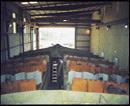
Issue: Wiggling through 18 inch portals can be difficult enough without having to drag a large wire feeder behind. A shipyard's rough, humid and corrosive environment can make feeder breakdowns a common occurrence, too. Bollinger Shipyard's operators face these challenges daily.
Solution: Miller's SuitCase 8VS ultra-portable wire feeder is 25 percent smaller and lighter than other portable feeders, and its high- impact polymer case resists damage from abuse and corrosion.
Results: Improved portability for freedom of movement and a durable design that eliminates feeder breakdowns. Bollinger can complete projects on time every time.
You know the one about trying to fit 10-lb. of dirt into a 5-lb. bag? In shipbuilding, an 18-in. portal equals the bag and bulky welding equipment is the dirt — and no operator likes hauling extra dirt through the scores of portals that comprise even a modest vessel. That's one reason why Bollinger Shipyards, Inc.'s Melvin “Stoney” Jones, welding supervisor and CWI, and Carl J. Breaux, welding foreman, tested and subsequently purchased the ultra-portable SuitCase 8VS™ wire feeder from Miller Electric Mfg. Co.
Bollinger is the foremost provider of marine repair and conversion services and a leading provider of new construction services to the energy, commercial and government marine markets in the Gulf of Mexico region. Vessels include barges, tugboats, liftboats, oilfield supply vessels, fast patrol boats and other carbon steel, stainless steel and aluminum products. Bollinger operates 14 shipyards with 42 dry-docks, all strategically located between New Orleans and Houston with direct access to the Gulf, Mississippi River or Intracoastal Waterway.
Stoney Jones works at Bollinger Marine Fabricators, L.L.C., a 67-acre dedicated barge building facility in Amelia, La. Current and recent projects include 260-ft. hopper barges that can carry 3,000 metric tons of phosphate rock, fertilizer or coal; double skin tank barges designed to move 12,000 barrels of sulfuric, phosphoric acid or molten sulphur; and a 200-ft. water barge whose eight tanks each hold 51,000 gallons of potable water.
Breaux works at Bollinger's headquarters facility in Lockport, La., and focuses on new construction. Current projects include delivering 50 Coast Guard patrol boats, which range from 87 to 170 ft. long and can attain speeds up to 35 knots, and several 145.5 ft. supply/utility vessels. The vessels have a maximum deck load of 390 tons and capacities for 50,000 gal. of drilling mud, 60,000 gal. of fuel, 560 gal. of oil and 10,000 gal. of fresh water.
Those tonnage and gallon capacities are important because it demands dividing the vessel's interior into many separate compartments — all welded from the inside and accessed through a portal once the deck is in place.
“The portals are 18 in. wide, and operators have to scoot down and crawl through the bulkheads, then turn around and drag the wire feeder, leads and other equipment after them,” says Breaux. “Sometimes they spend the whole day welding inside the hull, and the operators like the SuitCase 8VS because of its convenient size and weight. They'll haul a big, boxy feeder if they have to, but that little SuitCase is much easier to tote around.”
Travel With A SuitCase
Approximately 25 percent smaller and lighter than other portable feeders, the SuitCase 8VS measures 14-1/2 x 6-1/2 x 15-5/8 in., weighs 23-1/2 lb. and holds an 8-in. wire spool. For welding hulls and other carbon steel structures, Bollinger uses 8-inch spools of Tri-Mark's Triple-7 E71T-1 flux cored, gas-shielded wire in .045 and .052 in. diameters. For short circuit welding on water, sewage, and mud piping, Bollinger uses 8 in. spools of .035 in. ER70S-6 solid wire.
“We like the SuitCase because it's so portable,” seconds Jones. “We use it on pipes from 2-1/2 to 72 in. in diameter, and those big pipes [the legs to liftboats] we weld from the inside. We can put it inside pipes or tanks and weld without damaging the feeder.” Here, Jones refers to the wire feeder's second-most important characteristic: durability.
Tested Reliability
The Amelia facility, like most Bollinger operations, runs two nine-hour shifts to maintain its reputation for consistently delivering vessels on time. Easily damaged, problematic wire feeders won't cause Bollinger to miss a deadline, but they do add greatly to maintenance and inventory costs for spare feeders and parts.
“That Suitcase is so durable, I haven't had a single breakdown in six months — not even a minor breakdown. Typically,” states Jones, “feeders go down once or twice a week.” Isaiah Thomas, maintenance leaderman, concurs. “Just about every day we have some type of problem with our other portable feeders. Most of the time we have board problems or other things that go out on them. But with the Suitcase, we haven't had one service call on them,” he says. “That's why I always prefer Miller — their machines are more maintenance-free, and I've been doing this a long time.”
Jones first gained confidence in the Suitcase 8VS's durability when he witnessed it undergoing reliability testing during a tour of Miller's Appleton, Wis., facility. “I saw Miller duplicating the kind of humidity and corrosive salt environment we have on the Gulf Coast, and it impressed me. Miller didn't hide anything — they even showed me the test paperwork and indicated areas where they improved the design. That's what sold me on the Suitcase 8VS.”
In addition to corrosion protection, the Suitcase 8VS's high-impact polymer case resists bending and breaking better than metal cases, and heavy-duty locking hinges withstand more abuse than those on other units. Other durability features include a recessed wire feed speed control knob, a gas hookup positioned near the bottom of the wire feeder to alleviate tipping and a carrying handle that folds down out of the way (yet large enough to fit a gloved hand). The open space surrounding the wire drive rolls also lets operators adjust tension with a gloved hand.
Building a Barge
Barges and other vessels begin life as 3/8- to 3/4-in. steel plates that enter the Amelia facility's material prep area. Here, two huge computer- controlled plasma cutting tables slice the metal into pieces as large as deckplates or as small as 12 in. brackets. Hydraulic presses bend and shape parts. Though much of the steel comes already primed, Bollinger also shot blasts and primes any uncoated steel.
Next, the steel flows through Shop One, which contains a tandem submerged arc welding station for welding a barge's major subcomponents, such as the transverse bulkhead (a.k.a., deck), hull and panels. Next comes an eight-torch, automated seam welder. It welds the hundreds of long angle irons that stiffen and reinforce the otherwise flexible plate without adding too much extra weight. Think of this station as a programmable, over-sized stitch welder. For example, in a “3 on 12” setting, each of the eight torches makes a 3-in. long fillet weld every 9 in. on the outside radius of eight separate angles. Jones affectionately calls this the shop's bread and butter machine because of its 30 IPM travel speeds.
After Shop One, the large, flat weldments go to Shop Two and Shop Three for “stick building,” or piece-by-piece assembly.
“A vessel such as a 400-ft. barge is too long to build all in one unit,” says Jones. “We break its fabrication into modules, with each module ranging from 30 x 40 ft. to 40 x 60 ft. For example, a barge could have bow and stern modules for port and starboard sides and several mid-body modules.” Positioned side-by-side, the modules resemble a string of intermodal shipping containers.
The modules then exit the protective cover of a shop (lifted by 30- and 90-ton cranes) and move to the Erection Area. Here, operators weld the modules together, shoot three to four dozen x-rays to check weld quality and then test for water tightness by applying 2 lb. of pressure per square inch.
The next station adds finishing components (bumpers, railings, deckhouses, etc.) and the last station involves painting. Then, with a giant splash, the barge slides sideways into Bayou L'Ourse and onto its final destination, which could be up the Mississippi, through the Panama Canal or to the Middle East.
Mostly Flux Cored
From Shop One on, banks of 300 and 400 amp welding power sources line the shop walls. Approximately 170 welding operators (more or less, depending on work volume) connect long leads to suitcase-style wire feeders.
“We use flux cored welding for almost everything,” says Jones. “Bollinger got away from Stick welding more than 20 years ago. Flux cored welding is quicker, cleaner and faster, which you need to compete in today's market.”
Bollinger's operators must weld in all positions in confined spaces, such as when welding the deck to the rest of the structure. Flux cored wire helps because its fast-freezing slag permits the operator to use higher current to deposit more metal faster while still producing a flat bead in all positions. Operators especially appreciate its low fume level when welding in confined spaces.
Universal Feeder
Knowing that shipyards often use a wide variety of welding machines, Miller designed the Suitcase 8VS to operate on open-circuit arc voltage. This allows Breaux and Jones to connect the Suitcase to almost all of Miller's and most competitive CV or CC DC-type power sources. It also eliminates the need for a control cord between the power source and the feeder, giving the operators one less cord to drag around.
With the flexibility to connect to different power sources, produce excellent results with flux cored wires as big as .052 in. and short circuit weld with hard wires as small as .023 in., the Suitcase 8VS can help Bollinger standardize on one machine for most of its welding needs. Coupled with its unmatched portability and durability, the Suitcase 8VS will help Bollinger produce high-quality ships and deliver them on time for years to come.


